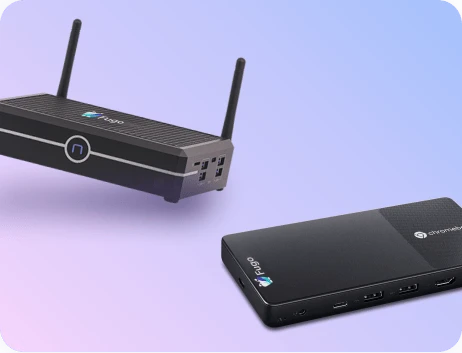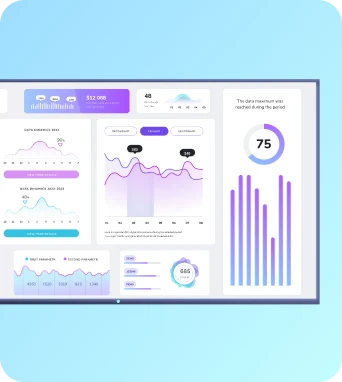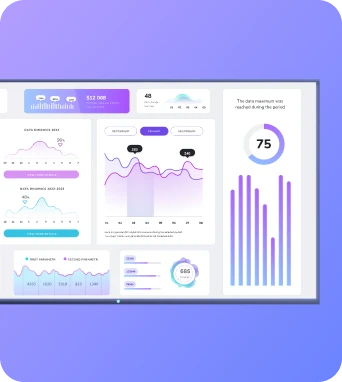You’re a restaurant owner — of course you’ve thought about installing digital menu boards. Maybe you’ve been thinking about diving in headfirst, or maybe you’re feeling cautious and wondering how much work it will take to make one.
But honestly, at this point, you just want to learn more. So lucky for you, we’ve made it easy to get started. 🚀
This guide explains (pretty much) everything you should know about digital menu boards for restaurants. We cover the types, benefits, and how to set them up, plus explain why Fugo is one of the best options for growing small businesses.
But first: what are digital menu boards for restaurants?
For the less familiar, digital menu boards are a method of displaying menu items on a digital screen. This makes it easier to manage restaurant digital signage — like displaying menu items, promotions, and pricing — so you can boost your customer’s experience without making life more difficult for your team.
What can you display on a digital menu board? Probably more than you’d think. Customers might feast their eyes (pun intended) on:
- Labels for dietary restrictions
- New product videos
- Social media feeds
- Breaking news
- Nutrition facts
- Menu options
- YouTube
- And more
- Websites
- Weather
- Time
- Polls
Digital menu board management usually requires a content management system (aka a CMS) to push content to TV screens. The best ones usually come with customizable templates, dynamic digital menu boards, and interactive digital menu boards, which are perfect for restaurants looking to create a unique brand image and enhance customer engagement.
But don’t worry, we’ll get into all that later. 😉
💡Related: 10 Ways To Use Digital Signage In Your Restaurant
Types of digital menu boards
You can set up digital menu boards on TV screens, dedicated LEDs, video walls, kiosks, and much more. All you need is a digital menu board solution to help bring your vision to life.
There are typically three types of digital menu boards:
Static digital menu boards
You can think of static digital menu boards like PowerPoint slides or still images — they’re menus without extra movement, animations, or interactive elements.
This option makes sense if you have a small menu and don’t change your offerings throughout the day (like between breakfast and lunch, for example).
But the truth is that static menu boards aren’t all that, well, engaging. They’re not much more than transcribing a paper menu to a digital screen — and if you’re looking for ways to upgrade your menu system, it might make sense to look for something more dynamic.
Which leads to our next point:
💡Related: 4 Advantages of Digital Menu Boards Over Static Menu Boards
Dynamic digital menu boards
Dynamic digital menu boards are animated and/or auto-updating menus that give you more flexibility than static screens. You can use them to schedule content based on the time of day, rotate through promos, or display motion-based content like GIFs, videos, or ticker-style announcements.
This type of menu board works great for restaurants with shifting menus (think breakfast, lunch, and dinner rotations or happy hour deals). If you run multiple locations, you can also use dynamic boards to push updates across all stores at once without logging into each screen manually.
Just keep in mind that too much motion can overwhelm customers if it’s not designed thoughtfully. You’ll need to pace your animations and keep your layout clean so it can support decision-making rather than distract from it.
Interactive digital menu boards
Interactive digital menu boards let customers tap, swipe, or scroll through your menu on their own. They can browse categories, check out nutrition info, and even place orders right from a screen.
Interactive signage works best for self-serve kiosks, high-volume counter-service spots, or any type of brand that wants to create a more high-tech experience. You can also use interactive displays to collect feedback, let customers customize meals, or share relevant promotions based on their history or actions (helloooo, loyalty programs).
Of course, interactive digital menu boards need you to invest in touch-enabled hardware, which isn’t always cheap. You’ll also have to think through your UX flow carefully — because if it takes more than a few taps to get what they want, customers may bail before placing an order.
The many benefits of using digital menu boards for restaurants
There’s a lot more to digital menu boards than just pictures of delicious food (although to be honest, that’s a big part of it).
The truth is that digital menu boards can save you time and money while engaging customers more deeply than paper or posters.
Here are just some of the many benefits of using restaurant digital signage:
- Put more dollars in your pocket. You can turn your restaurant’s TV screens into consistent revenue by cross-selling and upselling 15% more often, improving viewership by 400%, and ultimately leading to a passive sales increase of 2% to 5%. You also save money on expensive print costs, which can range up to $50 per menu (or more!).
- They’re ridiculously easy to update. Sold out of your lunchtime special? Just tap a few buttons and boom: it’s off the board. No whiteout, reprinting, or handwriting required.
- They work across multiple locations. Whether you’re running three cafes or a dozen burger joints, digital menus make it easy to keep everything consistent (and compliant) in your region.
- They shorten the wait — at least in people’s minds. Drool-worthy visuals and menu teasers keep customers engaged, which makes wait times feel up to 35% faster (even when they’re not).
- They show off your food at its best. High-res photos, subtle animations, and clean formatting make even your side salad look like a showstopper.
- They help you stay flexible. Maybe you want to promote a new combo, flash a happy hour deal, or highlight your gluten-free options. Either way, you’ve got full creative control in real time, along with ultra-easy tools for switching content by day or time.
TL;DR, digital menu boards can seriously upgrade how your business shows up (and how customers perceive it). They look sharp, they work smart, and they’re incredibly convenient for growing brands.
All that’s left is to make one for yourself. 😁
How to turn your TV into a digital menu board
Some of the world’s most popular fast food restaurants use digital menu boards to bolster their brand.
But that doesn’t mean you need to be a household name to start. In fact, most digital menu boards for restaurants cost around $20 per month or less.
Here’s how to get started in four easy steps.
Pssst — don’t have time for each section? Skip to the end for a lighting-fast tutorial.
1. Buy the hardware and software
As the title implies, this means getting all the right tools for the job. You typically need three: a TV screen, a digital signage player, and a CMS to push your content to said players.
Let’s take a closer look:
- Buying the right screen(s). Already own a TV screen? Fantastic! You’re pretty much ready to roll. But maybe you want something more specific, like a kiosk or an outdoor display. That might require a little more time for research, so be sure to plan accordingly.
- Purchasing the right hardware. Do you need a digital player to sync content across your screens? What about cables, casting tools, or solutions without WiFi? Thinking through everything up front means no surprise expenses down the road, which could be disastrous in certain situations or expectations.
- Choosing the perfect content management system. There are lots of different options on the market (including Fugo) that can help you create, adjust, and display finished content. And we may be biased, but we genuinely believe that Fugo makes digital signage easier for small businesses.
P.S., if you’re curious why we think Fugo has a place in the winner’s circle, check out our guide to the 10 features your digital menu boards software needs to have.
P.S.S., Fugo offers a 14-day free trial so you can get up and running in 15 minutes or less. You can always try before you buy and see why our software is the perfect fit for growing restaurants. 😉
💡Related: 5 Tools For Creating Digital Menu Boards
2. Design effective menus
You’ve got the screen — now it’s time to make it shine. Knowing how to make a beautiful menu can help you make faster decisions, boost sales, and keep your brand consistent across every location.
A few tips to get you started:
- Organize your menu with color-coded categories and clear headers so customers can find what they need without squinting.
- Use high-quality photos and short, punchy descriptions, especially for your top-margin items.
- Highlight promotions and special meal combos to nudge people toward bigger orders.
- Keep pricing easy to scan. And pro tip: never hide your decimals in tiny font. That will only come back to bite you later and potentially affect your compliance status as well.
- Use dynamic scheduling for different menus (like a breakfast menu from 6 AM to 10 AM and a lunch menu from 11 AM to 3 PM).
Feeling stressed about design? No worries: Fugo comes with drag-and-drop templates made specifically for restaurants. That way you can build a killer digital menu in minutes, not hours. And beyond menus, you can also build displays with QR codes, social media walls, and even digital bulletin boards for business “regulars.”
Want to try your hand at designing a digital menu board? Take a peek at our guide on how to create a digital menu board.
3. Implement your digital menu board
Now that the content is ready, let’s prep your screens. And TL;DR, all you really need is a decent mounting spot, plus the right cabling and hardware to tie everything together.
First, make sure your screens are mounted in high-visibility spots (think above counters, near entrances, or wherever customers stop to think).
Next, connect your TVs to your digital signage players. The best CMS systems can connect from everything from Amazon Firesticks to Google TV streamers and commercial displays, so you’re practically spoiled for choice. That said, it’s still a good idea to check that your player and screen(s) play nicely.
The final step is connecting your TV screen to your CMS software, which will ultimately depend on the solution you use. If you’re using a platform like Fugo, for example, you can refer to one of these OS and device setup guides for:
- How to Use NVIDIA Shield TV For Digital Signage: A Beginner’s Guide
- How To Use the Amazon Fire TV Stick For Digital Signage
- Guide to Fugo with Samsung Consumer Displays
- Install Fugo on LG Display via URL - Step-by-Step Guide
- How To Install & Troubleshoot Fugo On Your Android Device
- How To Install Fugo On Your Amazon Device
4. Update and manage content
All that’s left is to update and manage your content. The good news is, it’s easier than you’d think.
Because you’re no longer stuck printing new signs every time you swap a special. Updating a menu with your CMS takes seconds — whether you’re changing prices, highlighting seasonal items, or running a limited-time combo.
With Fugo as your digital menu board provider, you can:
- Schedule updates in advance (like launching breakfast at 6 AM or flipping on your happy hour by 4 PM)
- Run promos and upsells automatically, such as adding animated content or limited-time offers that pull people in
- Keep your branding consistent across every menu with custom fonts, colors, and logos
- Embed live social walls, QR codes, or loyalty updates to keep your regulars engaged and offer social proof to your customers
The cherry on top? You can manage all this remotely. Since Fugo is cloud-based, you can manage everything from anywhere — your office, back-of-house tablet, or even your phone if you’re in the middle of a meeting. 🙃
Why choose Fugo.ai for digital menu boards for restaurants?
Not to toot our own horn, but we genuinely believe that Fugo is the easiest way to create quality digital signage at scale.
But why take our word for it when you can see for yourself?
Here’s why Fugo offers the best digital menu boards for restaurants:
Free Design Studio and digital menu board templates
Fugo’s intuitive and easy-to-use Design Studio allows you to craft stunning digital menus without any design experience. You can also use one of our digital signage templates in your cafe, quick-service restaurant, and everything in between.
Want to try building your own digital menu board? Fugo makes this incredibly easy.
First, add a background image, videos, and animations to make your menu stand out from the crowd. Then, add all the bells and whistles, like items, descriptions, categories, calories, prices, and so much more.
Simple content scheduling in real time
Fugo can help you instantly update menu items, prices, and promotions across all your locations. You can also schedule content to display at specific times — such as breakfast specials in the morning or happy hour deals in the evening — so your menu remains relevant throughout the day.
You can also customize your menu boards by:
- Centralizing screen management into a single, simple app
- Monitoring the uptime of your devices from anywhere, even remotely
- Set up flexible content scheduling (either recurring content scheduling or priority takeovers)
- Creating publishing and account hierarchies to keep sensitive data protected
- Scheduling promotions, LTOs, and much more within sections.
Hundreds of tools and third-party integrations
Fugo can integrate with all sorts of third-party hardware and software so you can connect to the tools you already love.
For example, you can integrate effortlessly with smart TVs, professional displays, and/or external media players so you don’t need to worry about compatibility issues (or spending extra or devices you don’t really need).
You can also connect with all sorts of digital signage software to make your restaurant menu boards even more, well, you.
For example, you might connect with:
- Canto or Dropbox for easier DAM management
- QR codes that encourage customers to take action
- Spotify to play music and show off your playlists
- YouTube to embed videos of your business and products
💡Related: The Top 10 Digital Signage Integrations
Get customers to stop, look, (touch), and order
With Fugo, you can easily create dynamic content that captures attention and influences purchasing decisions.
For example, you might highlight best-sellers, or limited-time offers, or new items to drive sales and boost your customer’s dining experience.
Or, if you already own touch-enabled hardware, you could create digital kiosk forms so customers can order their food directly from your screen.
P.S., for advanced features like menu ordering and/or POS integration, our team can help integrate with your web applications. Really!
Set up your first digital menu board with Fugo
Creating beautiful digital menu boards for your restaurant doesn’t have to be complicated. It only takes minutes to launch a menu board with Fugo, the best digital menu board software solution for quick service, sitdown restaurants, local dives, and beyond.
It takes just three steps to get started with Fugo:
- Sign Up: Kick off with a 14-day free trial and explore Fugo’s features for yourself.
- Design: Take our Design Studio for a spin or customize one of our free templates to create a stunning menu that looks good from every angle.
- Manage: Create dynamic screens, advanced scheduling, and day-parting, plus optional bolt-ons like audio management, digital ordering systems, stock management, POS, and beyond.
- Deploy: Publish finished menus to your screens and manage them right from your laptop, whether you’re juggling one screen, multiple TVs, or 10 unique locations.
For all these reasons (and many more), it’s clear that Fugo is the easiest way to create digital menu boards for restaurants.
But why take our word for it when you could take theirs?
See why dozens of restaurant owners trust Fugo to support their fast-growing businesses.
Digital menu boards for restaurants: frequently asked questions
Q: How much does a digital menu board cost?
A digital menu board can cost anywhere from $20 per month to $2,320 per month based on hardware, software, and maintenance charges. This means if you already have a TV in your restaurant, you could get started for less than a Double Bacon Quarter Pounder meal. 🍔
Learn more about the cost of digital signage.
Q: How do I turn my TV into a menu board?
First, sign up for a 14-day trial of Fugo. Then, use a digital menu board template or create a custom display from scratch. Finally, you can set up dynamic display rules (like time-based displays) and push your content to specific screens.
Q: Are digital menu boards just TVs?
They can be if you want! You can use almost any display to show off digital menu boards, from consumer TVs and digital signage displays to kiosks, company TV channels, and more.
Q: What are the disadvantages of digital menus?
Digital menu boards can sometimes be slow, clunky, and expensive. They might also suffer from software or security issues if you’re using a legal provider. But if you choose the right CMS solution, this will rarely (if ever) be a problem. Digital signage solutions like Fugo make it easy to display restaurant menu boards quickly, easily, and securely.






